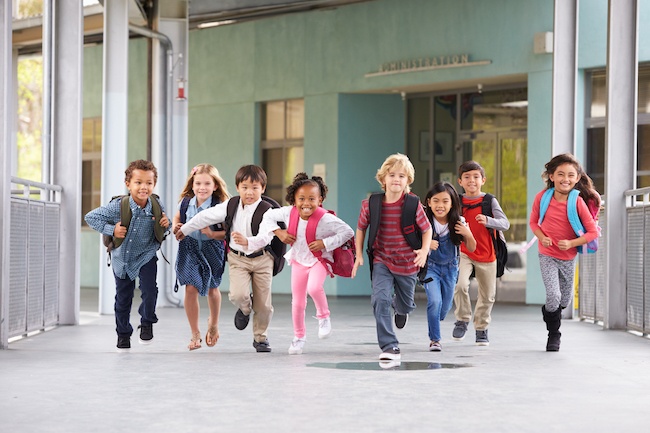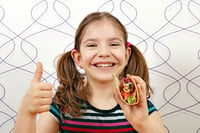
In multiple schools across the United States, students eat their lunch before heading outside for recess. Emerging evidence suggests that scheduling recess before lunch may offer many benefits, including better behavior, less food waste, increased ability to focus, and improved academic achievement.
Recess Before Lunch Leads to Better Behavior
The playground is a great place for playing games and releasing energy; however, it can also lead to high tension situations and disagreements among students. If students return to class immediately after recess, they may carry their problems into the classroom and cause disruptions. Serving lunch after recess allows time to resolve disputes and reduces conflicts in the classroom.
The Montana Team Nutrition Program conducted a four school trial run in the spring of 2002-2003 that switched the placement of recess and lunch to monitor the effects. Central Middle School, an elementary school that participated in the trial and continued with the recess before lunch model, reported a 60 percent decrease in disciplinary actions during a three-year period.
Additionally, Central Middle School saw lunchroom discipline problems drop from 183 per year before the lunch program changes to only 36 in the first eight months of the 2002-2003 school year.
After lunch referrals to the principal's office for classroom and other behavior problems also decreased. They went from 96 referrals in the 2001-2002 school year, to just 22 referrals in the first eight months of the 2002-2003 school year.
Recess Before Lunch Reduces Plate Waste
When students have lunch before recess, they often rush through eating in order to play outside sooner. This leaves them much less nourished as well as potentially more distracted as the school day goes on.
Recess before lunch allow students to utilize their entire lunch period because they are not rushing to go outside. Children also eat more after playing because they burn some of their energy and work up an appetite.
According to the Montana Team Nutrition Program, plate waste is the amount of food an individual leaves behind as a metric for how much he or she has eaten. This determines whether or not the student ate a well-balanced, nutrient-dense meal.
After implementing the recess before lunch model, students at Central Middle School showed a 50 percent reduction in plate waste. Furthermore, milk consumption increased notably.
Students Who Have Recess Before Lunch Have More Focus During the Afternoon
When recess follows lunch, teachers usually spend time getting students refocused on academics. Switching the order changes everything. The students calm down while they are refueling and enter the classroom ready to learn.
Teachers at Central Middle School reported increased attentiveness in their classes after lunch when recess came first. They found they gained about 10 minutes of instructional time per class.
Students Who Have Recess Before Lunch Have Improved Test Scores
According to Katy Taylor, Director of School Nutrition, in a study by Ector County Independent School District, test scores improved in the recess before lunch model. Across the 28 elementary campuses in the district that participated, elementary schools that scheduled recess before lunch scored significantly higher on third-grade reading, third-grade math, fourth-grade writing, and fourth-grade math.
Recess Before Lunch Reduces Play Related Injuries
Those in support of recess before lunch argue that exercising after eating results in more time at the nurse for head and stomach aches.
Post-recess injuries and stomach aches are one of the reasons North Ranch Elementary School in Scottsdale, Arizona, changed its schedule. In addition, other elementary schools that switched to the recess before lunch model reported healthier, happier students.
Recess Before Lunch Is Considered the Current Best Practice
According to a study published in The Journal of Child Nutrition and Management in the spring of 2016, environmental factors may influence food consumption. This includes the amount of time kids have to consume lunch, time of day lunch is served, food items served, and placement of recess in relation to the lunch period.
The study cites research, by Getlinger et al., that reported plate waste decreased from 34.9 percent to 24.3 percent when recess was before lunch for first grade through third grade. A different study noted no effect with food, but far greater milk consumption (Hunsberger, McGinnis, Smith, Beamer, & O'Malley, 2014; Tanaka, Richards, Takeuchi, & Maddock, Otani, 2005).
Based on all the available data, the Journal of Child Nutrition and Management study finds that recess before lunch is considered most desirable practice for its ability to decrease plate waste, increase consumption of school lunch, and calm lunchroom and afternoon classroom environments.
Challenges to Consider When Adopting the Play-Before-Eat Concept
While current best practices favor recess before lunch, the solution also presents some challenges.
One challenge school administrators face is the transition time involved for students to remove their outdoor apparel as well as where to put it. The need for hand washing after recess also presents a challenge. Solutions to these problems include allowing students to put their outdoor apparel in their classrooms before eating and incorporating hand sanitizing dispensers at the entrance of cafeterias.
When these issues are addressed and corrected, the recess before lunch model is a great benefit for students and teachers in terms of nutrition, exercise, and academic experience.









